
Thank you for visiting HOJO website. If you have any enquiry, please feel free to get in touch with us at
▼ Akira Hojo
▼ Hojo Newsletter
▼ HOJO FACEBOOK





HOME > Green Tea >Tsukigase Zairai Sencha

Deep after taste that is equivalent to the top grade Phoenix Dan Cong Oolong
It gives unprecedentedly strong after taste; the after taste is even stronger than the Phoenix Dong Tian Xiang.
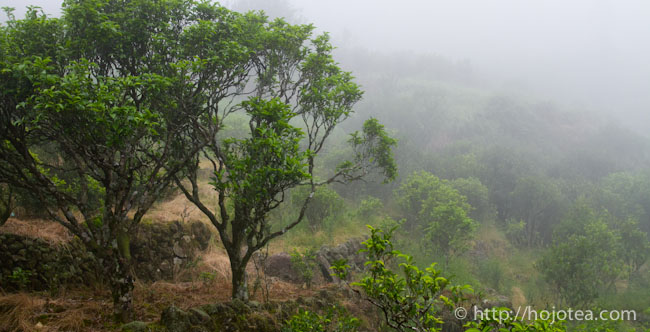
This photo shows the tea tree for Phoenix Dan Cong Oolong. Isn't it amazing that there is Japanese green tea that could equally compete with such an exclusive tea?
You may have completely different drinking experience when you sip this tea.
Tea goes down into the throat as it naturally flows. Its taste goes down very far deep into the chest and its sweetness stays there for a very long time.
It is exactly the feeling when we drink exclusive Chinese tea. The quality of the raw material used for making Tsukigase Zairai is outstanding. If it was made in China, it would be priced very high. Nevertheless, this tea is not expensive. Its price is very "friendly" thanks to the prejudice of Japanese quality criteria. I felt I found a treasure when I found this tea for the first time.
For us, the definition of quality is the "thick taste". Thick taste is unlike to the bitterness or astringency that we experienced when too much tea leaf is used or brewed for too long. The thick taste refers to the depth of taste, thickness of the after taste or long-lasting feeling of taste in our throat.
As for Tsukigase Zairai Sencha, it makes the taste of water becomes very soft and after taste becomes very strong. Even if you briefly brew this tea, you can still feel its overwhelming extent of after taste. In fact, with one piece of tea leaf, it is good enough to change the taste of water; the texture of water becomes very soft and smooth.
There is an interesting application using Tsukigase Zairai Sencha. I suggest Japanese customer to put one piece of tea leaf into miso soup. Miso soup becomes heavenly sweet and the taste goes far deep down the throat. Soup becomes thicker and it gives strong kicks. You can also add one piece of tea leaf into orange juice, yogurt, coca-cola or coffee. Believe it or not, just give it a try. When you drink and compare it side by side, you will experience a huge difference in taste.
This magical function occurs thanks to the existence of minerals, especially iron ion. The quality tea leaf has very tiny cells and they are very rich in polyphenol and iron. Iron posses stronger positive attraction to water molecules than between water molecules by itself. As a result, the hydrogen bond becomes stronger and it attracts the taste bud on our throat.
Tsukigase Zairai does not give typical Japanese green tea flavor. Most of the Japanese green tea gives a flavor that reminds us of cooked rice. This flavor comes from the excessive amount of amino acid inside the tea leaf. Amino acid is produced if nitrogen-based fertilizer is applied on tea tree. The more nitrogen-based fertilizer is being applied, the faster the tea grows and more amino acid is composed. This amino acid is called theanine. In my opinion, this is the index of low quality tea, as more typical flavor means more fertilizer is used. When tea is baked at the finishing process called "shiage", amino acid reacts with sugar and forms typical kind of flavor. This is called Maillard reaction. It is the same mechanism as creating the aroma of hot cake.
Without nitrogen-based fertilizer, tea grows at very slow speed. Tea will then composes more polyphenols, and more minerals will be accumulated inside the leaf. Tsukigase Zairai is planted without applying any fertilizer. That's why it is rich in minerals and polyphenols. For this kind of tea, it gives very refreshing flowery flavor because it has very less amino acid. If you brew this tea with short infusion, the taste is just like Taiwan oolong tea.
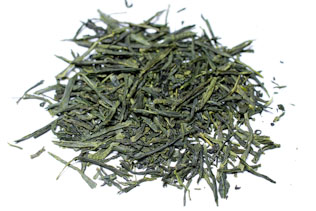
The leaf of Tsukigase Zairai Sencha does not look as beautiful as Shizuoka tea. Nevertheless, tea is meant for drinking. Once you drink this tea, you will be amused by its after taste.
Do you worry if tea keeps you awake?
For Tsukigase Zairai Sencha, you do not have to worry. This tea will makes you feel rather sleepy.
Tsukigase Zairai contains very high minerals content, especially iron. Tea with high mineral content drastically increases blood circulation. As a result, you feel warm and your face blushes. In our body mechanism, we feel relax and sleepy if our blood circulates better. It is the same as having acupuncture, massage or exercise.
No doubt this tea contains caffeine as well. However, the effect of caffeine will be overwritten by the effect of minerals. Tea that makes you sleepless is the common tea that has very less minerals. Another benefit of improving blood circulation is we can have deeper sleep, it also ease constipation problem and of course we feel less stressful.
If you drink Tsukigase Zairai more than a few hundreds ml, you may feel a little drunk. The feeling is just like you drink quality wine or whisky.
Well, believe it or not, please give it a try.
Tsukigase Zairai Sencha is produced in Nara prefecture, at Tsukigase town. But recently due to the government's policy, this town was merged into Nara city. Tsukigase is developed along Nabari river (名張川). This river flows through Kyoto and finally reaches Osaka. The name of the river also changed from Nabari river to Kizu river and Yodo river according to these three different places. In the history, it was the river for logistics. Naturally all tea gardens were developed along this river, and the city located at down stream was the main consumer of the tea. As I mentioned earlier, the down stream of this river is Kyoto. Historically the tea produced along this river, including Tsukigase Zairai Sencha, was sold as "Uji cha". Only a few years ago, due to the changes of the regulations, they stopped shipping tea to Kyoto. In general, tea produced in Nara is called "Yamato Cha". Yamato is the Nara's ancient name, and once upon a time, it was the oldest capital city of Japan back in AC 794.
Tsukigase is situated at the border of three prefectures, Nara (奈良), Kyoto (京都) and Mie (三重). Once upon a time, the Bira lake (琵琶湖)was much larger than now. Tsukigase area was at the bottom of this lake. As time passed by, the land rose and formed the present geographical feature. This is the reason that Tsukigase is very rich in red clay. In fact, Tsukigase is very near to Iga and Shigraki. Both places are known to produce very fine red clay in the history. From Tsukigase, it takes only a few minutes to reach Iga. Tsukigase tea has such good quality is mainly because of the red clay.
However, in Tsukigase, the fine soil only exist in certain areas. It is because of the specific geographical structure in Tsukigase. Very long time ago, the land might be flat and the top layer was rich in red clay. The gradual encroachments by Nabari river upon the land had formed the river terrace. As a result, the fine red soil only exists on the upper layer. The intermediate layer consists of red soil and sand, while the bottom layer has only white sand. Therefore, we only look for tea from tea garden situated at the highest level. I have also tasted tea produced from lower layer. As I anticipated, it tastes very flat and very light in aroma.
The following diagram shows the distribution of respective soil on the river terrace.
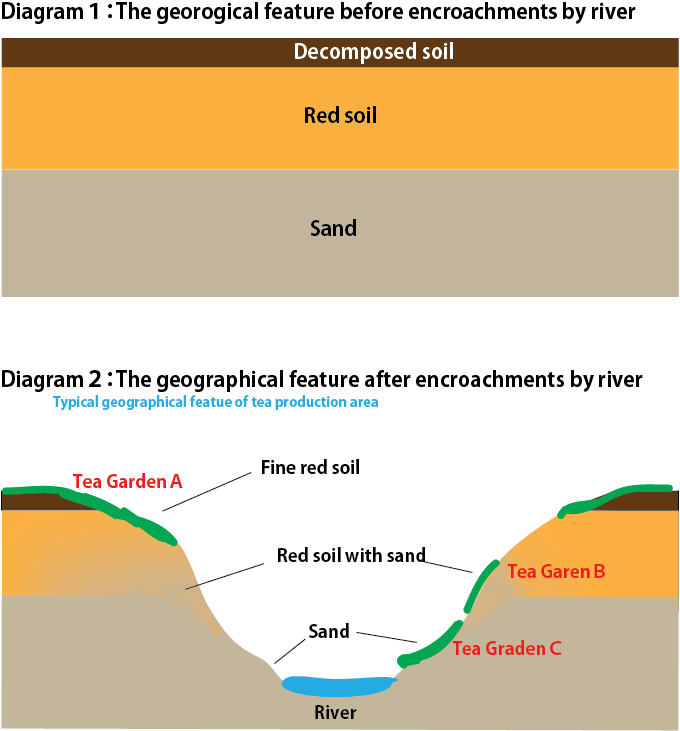
Tsukigase Zairai Sencha is literally produced from Zairai cultivar. In Japanese language, Zairai means "native". As tea is not the native plant in Japan, we regard Zairai as the original cultivator that remains the character of China bush. As Zairai is the direct decendant of wild tea, it has very long roots under the ground and it effectively absorbs minerals. If both Zairai cultivar and ordinary modern cultivar, such as Yabukita is produced under the same condition, definitely Zairai cultivar is of better quality. Zairai cultivar was planted by the seedling and it undergone complex natural hybridization. In a way, there are various kinds of genetic trait among Zairai cultivar. If we carefully look at the tea trees, each tree is different in terms of the shape of leaf, size and color. If you visit the tea garden that produces exclusive tea in China, you will notice the same situation. In China, these teas are called mixed cultivar. For example, Long Jing: the commercial quality is made of Long Jing No. 43, while the high-end quality is made of mixed cultivar. This term refers to the tea that carries original feature of wild tea.
Our Tsukigase Zairai Sencha is produced through natural production practices. Natural production is the higher version of organic production. Farmers do not use any artificial fertilizer even it is organic. They use only grasses or leaves collected from mountain to control the growing speed of tea. Tea grows almost in the natural condition. If nitrogen-based fertilizer, such as animal dropping is applied, tea will grow faster and it affects to the quality of tea.
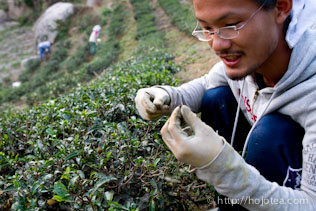 |
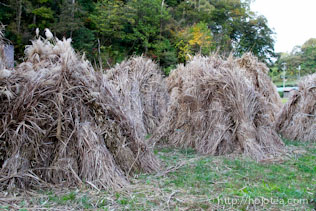 |
|
Remove insect by hand
|
Wild grass is applied after fermentation.
|
Usually tea tree is trimmed during autumn. In Japan, the common practice is to cut the branches at lower position. The branches left on the tree are as thick as straw. The bold branch effectively transfer the nutrition from the ground. With this method, tea leaf grows faster and the production quantity will be increased. As a result, the after taste of tea becomes very shallow and tea will accumulate a lot of amino acid synthesized from excessive supply of nutrients. This is the reason that most of Japanese tea gives very flat after taste as it contains large amount of amino acid. In Japan, people always said that good tea contains more amino acid. Of course it is not true. Good quality tea should contains more minerals and polyphenols but less amount of amino acid.
Tsukigase tea is trimmed only on the tip in very minor extent. With this practice, the branch becomes very slim; it is as thick as a tooth pick. Besides, the size of branch becomes very consistent, the leaf becomes very small and consistent in size, and the moisture content is distributed evenly. The leaf managed with this method looks yellowish green and it is very strong when I touch it. According to farmer, with this production method, tea leaf becomes less effective in absorbtion of nutrients. As a result, it grows very slow and substances in the leaf will be accumulated. This is one of the primary reasons that Tsukigase tea becomes good quality.
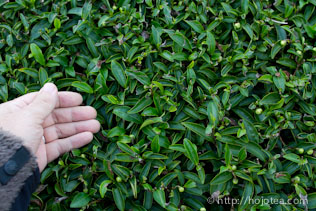 |
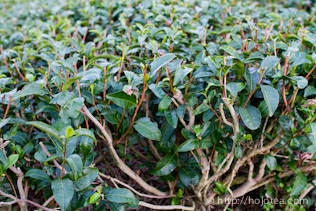 |
|
Natural ProductionThe shape, size and the color of leaf is very consistent. Leaf becomes small, yet it is very elastic and strong. |
Common ProductionIt consists of different size of leaf, different color and leaf looks weak. |
If you watch following video, you will learn more about Tsukigase tea.
In order to purchase the ideal tea, we evaluate various batches of tea from multi number of tea gardens. We only pick the quality we like the most. I am grateful to the family to give us the privilege.
In Japan, the quality criteria of tea are set by Shizuoka tea market and it was greatly influenced by the Japanese agricultural association. The agricultural association wishes to supply more nitrogen based fertilizer. They emphasize on "umami", and this comes from "thiamin", the typical substance produced when nitrogen based fertilizer is applied before harvesting. "Umami" is known to be the most important quality index of Japanese green tea; nevertheless, tea with very thick umami taste gives very flat and shallow after taste. Based on my experience, fruit or vegetable will not produce a good outcome if nitrogen based fertilizer is applied before harvesting. For example, if nitrogen based fertilizer is applied to vegetable, it taste becomes flat and flavour becomes very thin. If it is applied to apple or grapes, the tree grows very fast due to the nitrogen intake. As a result, fruit becomes very small and the taste is not enjoyable after all. The nitrogen based fertilizer does the same job with tea. It makes tea grow faster and increase the output. Certainly, farmers are happy since they have more volume of tea to sell. Agricultural association also feels happy because they can sell more fertilizer. Due to this close relationship among farmers and agricultural association, until now "umami" remains as the key quality index; even the professor in university is supporting this idea. If one has ever studied the very exclusive tea produced in China or Taiwan, none of the quality tea is produced with nitrogen based fertilizer. The higher the quality, the slower the tea grows. As less number of tea leaf dominate the limited minerals supplied from the root, we enjoy the thickness of the taste. Kasuga tea gives taste just like very high-end Chinese green tea or raw Puerh tea. If we ever taste this kind of Japanese green tea, it is hard to get back to the ordinary tea that just simply gives strong umami.
Pease click each photo to enlarge.
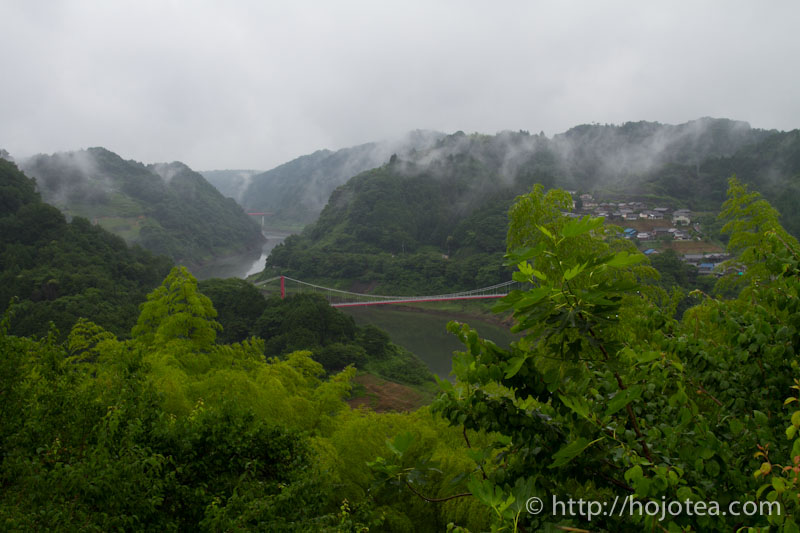 |
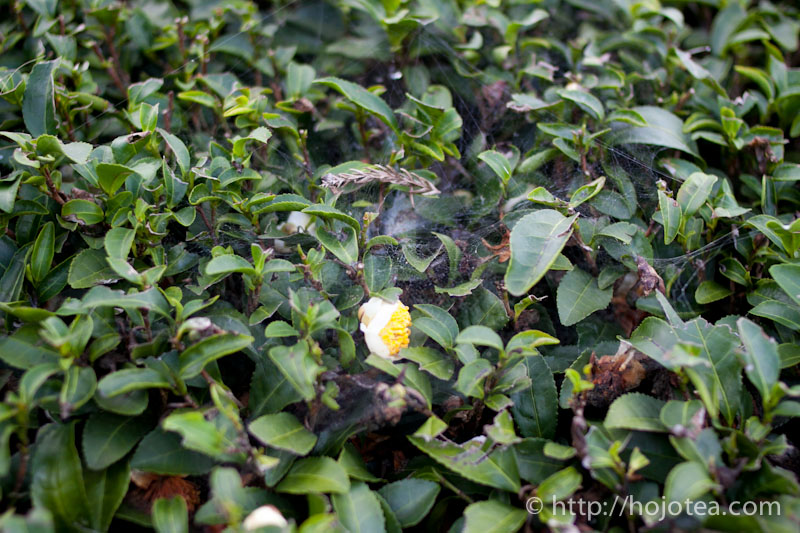 |
 |
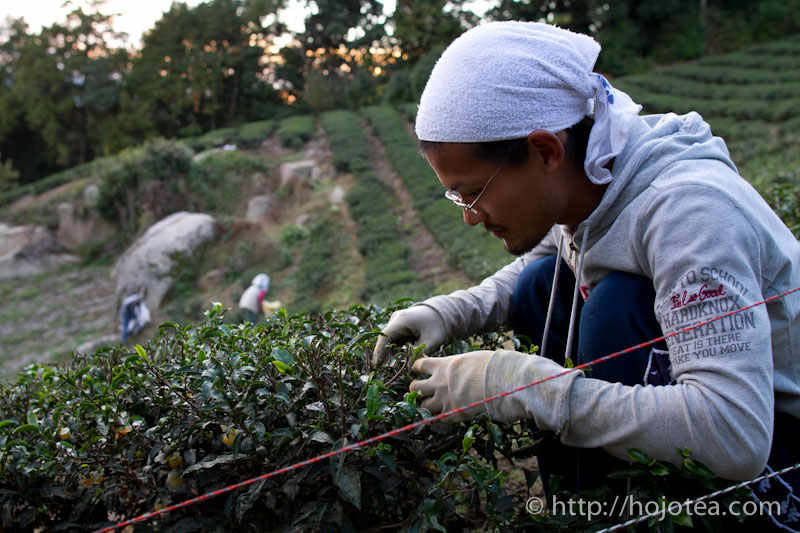 |
 |
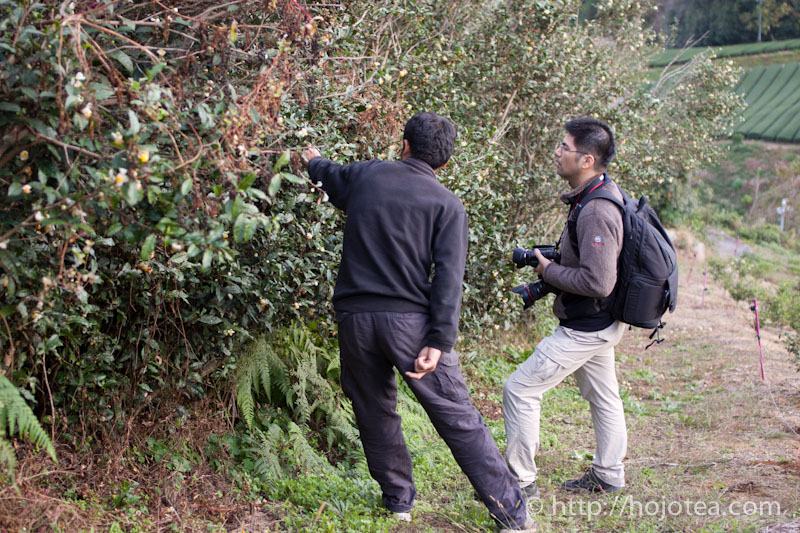 |
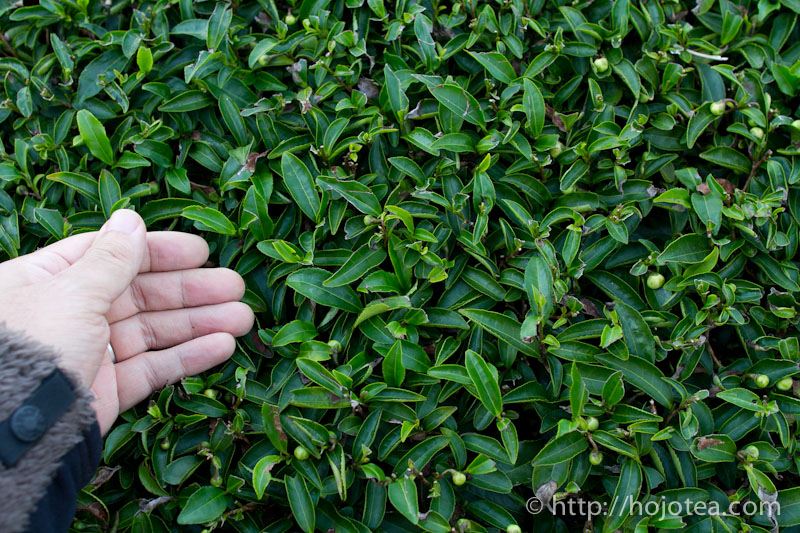 |
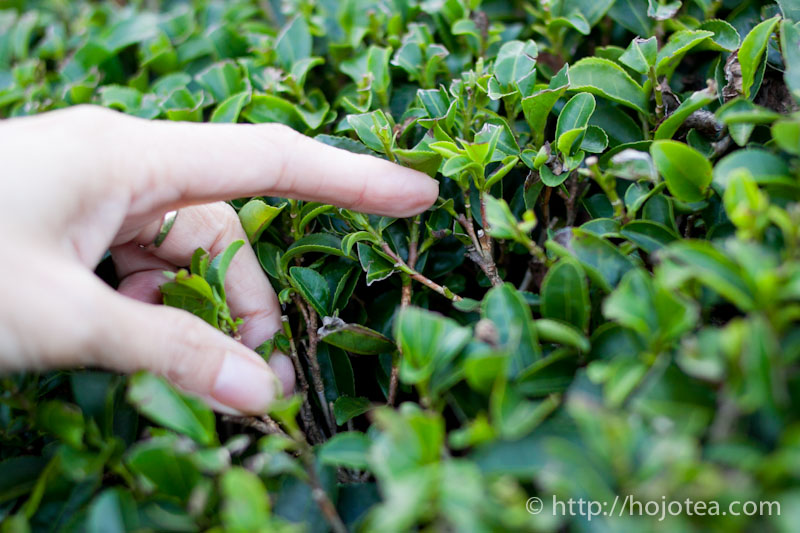 |
In you are using tap water, it is necessary to filter the water using an activated carbon filter. If not, you wouldn’t be able to enjoy the authentic taste of tea. Chlorine is added to tap water in order to sanitize bacteria. This chlorinated water will also harm our body cells. Concerning about our health condition, it is very important to remove chlorine from drinking water. The most effective method in removing chlorine is to install an activated carbon filter. This type of filter is designed for removing organic substance. It will remove not only chlorine, but also other harmful substance such as contaminated pesticide. The activated carbon filter can be easily obtained from the common hardware shop in most countries. If activated carbon filter is not available, please place a charcoal inside the water and leave it for over night. The material composed of activated carbon filter is made of ground charcoal. The difference is that activated carbon filter contains much finer particles and hence it has extremely large surface area for a better efficiency in filtration. We do not suggest RO water (reversed osmosis water) or distilled water. This water carries no mineral, the taste and flavor of tea tends to be very unstable, unless you have very superior quality tea and tea equipment.
In the long run, you may observe a thick layer of scale accumulated inside your kettle. Our mother usually taught us to wash and remove it with citric acid. But please do not even try to remove the scale. Scale consists of minerals that exist in the water. The mineral composition is reflected from the water you used. If you remove the scale, the mineral ion balance between scale and water is destroyed. This balance is called buffer effect in science. The flavor and taste will seriously run out and you won’t be able to get previous taste and flavor for a long time. It is also important to stick to the same type of water whenever brewing tea. If source of water is changed, it carries different type of minerals. It will affect the mineral ion balance too.
Go to further information about suitable water for brewing tea >>
The quantity of tea leaf can be calculated by a formula that "Divide the Volume of Water by 5". For example: the volume of teapot = 200ml; 200ml/50 =4g. You need to measure 4g of tea leaves for 200ml of water. As opposite to the traditional brewing method, the modern style uses more volume of water. A teapot with the size about 150-220ml is just nice for one person.
Tsukigase Zairai Sencha is very rich in poly phenol. You may enjoy the better outcome in terms of the flavor if you use the higher temperature for brewing. The ideal temperature to brew this tea is at around 90 degree C.
The first brewing period is 20 seconds to 30 seconds. Since the brewing temperature is higher, the time for the infusion should be short so as not to damage the leaf. The second brewing must be less than a few seconds. Please use the same parameter for the subsequent brewing.
Clay teapot and Tetsubin makes the taste of Sencha even better. It is mainly because of the iron that is released from the equipment. In particular, the iron enhances the depth of after taste.
Most of Green Teas can be brewed in cold water. The higher the grade of tea, the more suitable it is with cold water brewing.
1. Measure 1 table spoons of tea leaves for 500ml of water.
2. Pour the water into a glass jar or bottle and leave it for more than 1 hour.. It is also a good idea to put the tea leaves directly into a PET bottle.
3. Gently sway the container in order to get an even concentration.
4. Usually the taste of tea gets thicker when it is brewed for more than a few hours. In this case, pour in additional water. Eventually tea can be brewed more than 1 liter per 1 table spoon of tea leaves.
1. Measure 4-6g of tea leaves for 200ml of water.
2. Pour water into a clay teapot and brew for 3 minutes.
3. For second brewing, brew for 20 seconds. Alternatively you can also switch to hot water from second brewing onwards, if you wish. If using hot water for second brewing, pour boiling water and brew for less than a few seconds. Since tea leaves are very cold and wet, the temperature drastically drops to less than 60 degree Celsius.
The benefit of cold water brewing is tea can last for a whole day and the taste is refreshing with a natural sweetness. Thanks to the cold water extraction, the level of caffeine in tea is very low. You would not suffer from sleepless nights. Even kids can enjoy this tea.
Once a bag of tea is opened, please finish it within 3 months if you wish to enjoy its freshness. From the medical point of view, it is safe to consume the tea even if it is kept for a few years. However the freshness disappears if it is kept for too long. Tea must be tightly sealed before it is kept. Tea should be kept in ambient and dry conditions such as in the living room, but it must be completely away from humidity. Tea should not be kept in the kitchen as the environment is very humid. Avoid enclosed area such as inside the cupboard or drawer as these places are damp. Also avoid opening the bag of tea in humid atmosphere. It is recommended to open the bag during a sunny day or under air-conditioned atmosphere. Once tea leaves absorb moisture, deterioration of tea will be triggered within a few days. Tea will then give an astringent taste, sometime it tastes sour. The fresh aroma also becomes weaker.
The quality of tea lasts longer if it is kept in the fridge. However we strongly recommend you not to keep tea in the fridge. When tea is withdrawn from the fridge, there is usually condensation. Once tea is exposed to moisture during condensation, the quality will deteriorate within a few days. The higher moisture content in the tea leaves will trigger oxidation and it will completely destroy the quality of tea.
Here’s one frequently asked question: what happens if bag is sealed using tape or tea is packed in zipper bag and kept inside the fridge?
For your information, these simple sealing methods are not sufficient. When the bag is withdrawn from the fridge, it is cold inside the bag and therefore causes negative pressure. Air will be drawn from outside and condensation will occur. In addition, if the bag is taken in and out from the fridge very often, this will cause heat stress to the tea leaves as temperature is increased and decreased very frequently. If tea is kept in the fridge, when it is withdrawn from the fridge, it is necessary to leave it in ambient atmosphere for more than 24 hours in order to warm up the tea leaves. Based on our experience, 12 hours is not long enough. We may think tea is warmed up, but inside the bag, the tea leaves are still cold due to insulation effect.

Please feel free to send us e-mail for enquiry at:

 |
We accept various kinds of credit card through Paypal.
Only if customer prefer other option of payment, we suggest "Bank Transfer".
Various choice of shipping method
EMS, SAL, Small Packet, Small Packet (SAL) Yamato Express and Surface
For shipping tea, we usually suggest small air parcel, the estimated shipping cost of tea in 100g (with wrapping material ) is
Small Parcel
USA JPY 600, EU JPY600 and Asia JPY470
Small Packet (SAL)
USA JPY380, EU JPY380 and Asia JPY320
The shipping fee to oversea by small air parcel happens to be even cheaper than domestic shipping fee in Japan.
For your information, some countries, EU in particular imposes custom duty. We need buyer to bare the duty. We are sorry, but we cannot change the amount on the invoice, and we do not mark any packages as gifts. We will strictly follow the custom regulation.